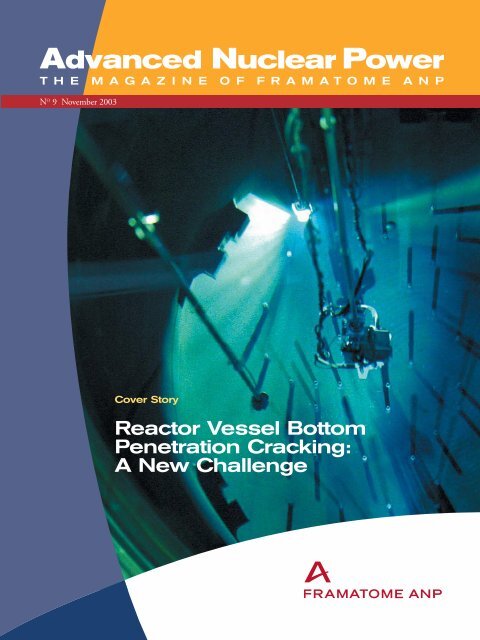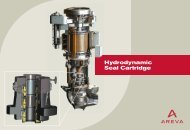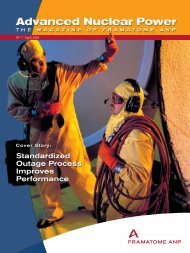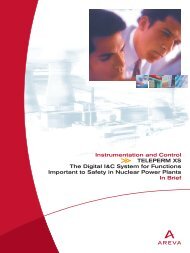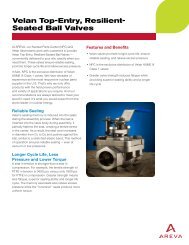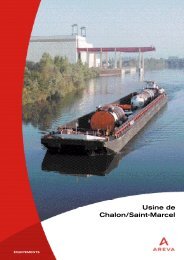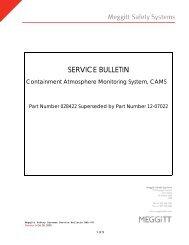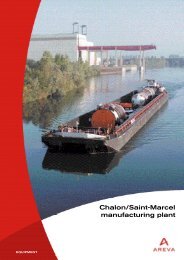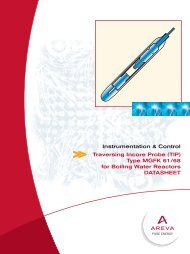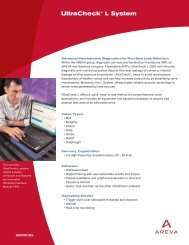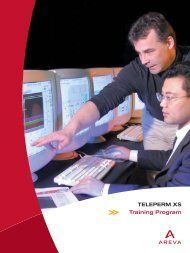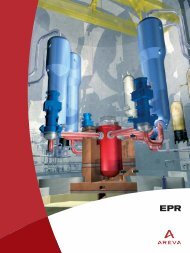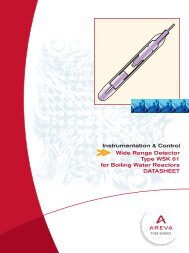Download - AREVA
Download - AREVA
Download - AREVA
- No tags were found...
Create successful ePaper yourself
Turn your PDF publications into a flip-book with our unique Google optimized e-Paper software.
Advanced Nuclear PowerT H E M A G A Z I N E O F F R A M A T O M E A N PN O 9 November 2003Cover StoryReactor Vessel BottomPenetration Cracking:A New Challenge
C O N T E N T SAdvanced Nuclear PowerN O 9 November 2003Framatome ANPWorldwide OfficesTour <strong>AREVA</strong>92084 Paris La Défense CedexFranceTel: +33 1 47 96 00 00Fax: +33 1 47 96 36 36FRinfo@framatome-anp.com3315 Old Forest RoadLynchburg, VA 24501USATel: +1 434 832 3000Fax: +1 434 832 0622USinfo@framatome-anp.comFreyeslebenstr. 191058 ErlangenGermanyTel: +49 9131 18 95374Fax: +49 9131 18 94927DEinfo@framatome-anp.comEDITORIAL STAFFPublisherNicolas BrunEditor-in-ChiefSusan HessManaging EditorMartha WieseRegional EditorsChristine FischerCatherine RouetPhilippe RouillerMartha WieseGraphic DesignThe O’Connor GroupContributing WritersArnold Bläser, Lothar Brücher,Jean-Claude Chesny, Alice Clamp,Reinhard Czech, Christine Fischer,Norbert Jakobs, Sabine Kueny,Gerhard Langmüller, Rick Piester,Joachim Specht, Martha WieseExternal writers’ articles express the opinionsand views of the author(s) but may notreflect the position of Framatome ANP.Perspective3 Nuclear Services: Quickly Finding SolutionsFor Emergent IssuesIndustry Insights4 Natural Gas Volatility– A Boon for Nuclear Power?6 US and EU Agree to Work Towards a Hydrogen EconomyCover Story10 Reactor Vessel Bottom Penetration Cracking:A New ChallengeFeatures8 New Filters Recover Megawatts at Pickering9 Strategic Planning Facilitates I&C Modernization14 Failure-Free Fuel Operation for a Combined 26 Years15 Innovative Radiological Monitoring NetworkProvides Greater Protection16 Platform Designed to Shorten Outage17 Framatome ANP Strengthens its Position in China18 Integrated Valve Maintenance Concept at NeckarDepartments20 News In Brief20 Contracts22 Equipment & Services23 Events and MeetingsADAM and SIPLUG are registered trademarks of Siemens.TELEPERM is a trademark of Siemens.ATRIUM and FUELGUARD are trademarks of Framatome ANP.Cover: The South Texas Project reactor undergoing inspection of itsbottom-mounted incore nozzles.
Perspective10Nuclear Services: Quickly FindingSolutions For Emergent Issues1421With plant aging, the name of thegame in the nuclear services businesstoday is finding the best solutionfor emerging problems as quickly as possible.Responding to such issues requires agility, broadcapability and experience and innovativeengineering. It also requires dogged pursuit andoften many hours of intense analysis, planning,mockup testing and training.The recent problems with Alloy 600 in reactor vessel (RV) heads andnow in the bottom mounted penetrations of some PWR plants are testing theingenuity, and perhaps patience, of all in the nuclear industry. New nondestructiveexamination techniques and tooling to deliver them have beenquickly developed to meet inspection requirements as well as new processes forcompleting repairs. Many plants are opting to replace their RV heads,but that is not an option for the bottom-mounted penetrations.Will the bottom-mounted penetration problem that surfaced at South TexasProject be the beginning of a trend? Candidly, we don’t know, and we probablywon’t until more analysis and visual inspections are completed later this year.We at Framatome ANP are in a unique position because the combinationof the knowledge base and expertise of our worldwide company, offers the mostcomprehensive and technologically advanced experience base in the industry.This, combined with our recognized reputation for responsiveness andservice, contributes to our leadership position in the nuclear service business.Regardless of what the problem is, we will be there to offer the best solutionwith the fastest response – guaranteed.George BeamSenior Vice President, ServicesFramatome ANP, Inc.An Areva and Siemens Company
Industry InsightsNatural Gas Volatility – A Boonfor Nuclear Power?Historically the United States andBritain have relied on a diverseenergy portfolio – including nuclearenergy – for electricity generation. Butas both nations become increasinglydependent on natural gas to fuel theirpower plants, are they putting low-costreliable electricity at risk?US electricity generating capacitygrew phenomenally in the 1970s and1980s. “Every five years, the nationadded 10 percent capacity until the1990s,” says Matthew Simmons,chairman of Simmons & CompanyInternational. “In the first half ofthe 90s, we added 6 percent capacity.In the second half, we added 2percent.” The reason? Restructuringof the electric utility industry hadbegun. Uncertain about the future,power companies delayed investmentsin their systems, expecting to meetdemand by importing electricity boughtin deregulated markets. “Everyoneplanned to borrow everyone else’sreserve capacity,” says Simmons.It was an approach that worked –until the exceptionally hot, humidsummer of 1999. Record-breakingelectricity demand from an overloadedgrid caused blackouts and brownoutsin the eastern and central parts of thecountry. These events triggered whatSimmons calls “the most unbelievableexplosion of power plant construction.”By 2003, the country had addedapproximately 220,000 MW ofnatural gas-fired power plants – twicethe capacity that experts said wouldbe built by 2010. The fuel of choice –driven by the nation’s environmentalpolicies – was natural gas.Natural gas demand has been spurred,in part, by its increased use “as aclean-burning source of electric power,”Unlike fossil fuels, nuclear fuel is not subject toprice volatilityAlan Greenspan, chairman of the FederalReserve Board, told the Joint EconomicCommittee of Congress in May 2003.While demand has soared, supply hasremained essentially flat. The result?A looming natural gas shortage – atleast in the short term. Energy SecretarySpencer Abraham said in June 2003that demand for natural gas has risento levels “that are difficult to sustainunder current supply and productionconstraints.” Spiking natural gas pricesspell higher bills for electricity consumers.The country has every reason to beconcerned, says Simmons. As theeconomy expands – and it will – thenation will need more electricity.“There is no realistic scenario inwhich the US gross domestic productsignificantly expands without anexpansion in the use of electricity,”says Simmons. In the short term, thatelectricity can come only from naturalgas-fired power plants. In the longerterm, some of that electricity mustcome from new nuclear power plants.Source: Nuclear Energy Institute, Inc.Acknowledging that natural gas demand“is a real serious problem,” the Fed’sGreenspan said in May that “we oughtto be spending more time at leastlooking [at] and contemplating theissue of nuclear power.”The nation is already heavily dependenton its nuclear power plants, saysFrank Clemente, senior professor ofsocial science at Penn State University.“What has saved us so far is theworkmanlike job of the nuclear energyindustry in increasing productivity.”Since 1990, the availability of USreactors has risen from about 70 percentto more than 90 percent, resultingin increased electricity production –equivalent to 26 new 1,000 MWnuclear power plants.What’s more, nuclear-generatedelectricity has the lowest productioncost of all major forms of electricitygeneration – 1.71 cents/kWh in2002. Natural gas has the highest –4.06 cents/kWh in 2002. And nuclearplants aren’t subject to fuel cost.4 Advanced Nuclear Power N O 9 November 2003
Source: Nuclear Energy Institute, USUranium, as a low-cost fuel for electricity generation,should be a part of any energy policyvolatility. Take the period betweenJuly 1999 and July 2002, for example.While the monthly uranium cost atnuclear power plants was an essentiallysteady $5 per MWh, the fuel cost atnatural gas power plants rose fromabout $37/MWh to $55/MWh, thensoared to $100/MWh. It fell to about$34/MWh before climbing again.The prospect of continued pricevolatility, supply constraints – andhigher costs – for natural gas-generatedelectricity is a powerful argumentfor the construction of a new fleetof nuclear plants.Britain gambleson natural gasThe United States isn’t the only countrythat has bet its future electricitysupply on natural gas. In Great Britain,natural gas accounts for 37 percentof electricity generation – a share thatis expected to rise as high as 65 percentby 2020. According to an EnergyWhite Paper issued by the governmentin February 2003, the UnitedKingdom will be a net importer ofnatural gas by 2006.In a State of the Nation assessmentissued in July 2003, the Institution ofCivil Engineers (ICE) warned thatBritain will no longer be largely selfsufficientin electricity generation. Thecountry’s coal-fired plants will closesoon after 2016, and only one nuclearpower plant will be operating after2020. No new coal or nuclear plantswill be built before 2020, according tothe government’s White Paper. Theshortfall in electricity generation willbe made up by gas-fired powerstations, which are expected to import90 percent of their fuel. Blackoutsare “very real possibilities” in less than20 years time, said David Anderson,chairman of ICE’s Energy Board.With 17 years advance warning, “weshould be able to head off the ICE’sgloomy scenario,” says Brian Wilson,former U.K. minister for energy andconstruction. He notes that nuclearenergy now provides nearly one-quarterof Britain’s electricity. “It is becauseof the presumption that nuclearwill wither on the vine that we needto project such massive reliance onimported gas,” says Wilson.Diversity is the current strength ofBritain’s energy base, says Wilson,“and we will surrender it at our peril.”The country needs a balanced energymix that is also secure and affordable,he says. “Renewables, nuclear andclean coal should see themselves asindigenous allies. The more there is ofeach of them merely means the lessreliance there will be on imported gas.”It’s a message the United States shouldheed. Like Britain, America needsto diversify supply, says Simmons.“And that’s coal and nuclear.” In themeantime, “we have to hope we don’thave another summer like we did in1999.” ■Advanced Nuclear Power N O 9 November 2003 5
Industry InsightsUS and EU Agree to WorkTowards a Hydrogen Economybasis that will promote the developmentof a hydrogen economy.Achieving a hydrogen-oriented economywill take 20 to 30 years, EU VicePresident Loyola de Palacio told thoseattending an EU conference onhydrogen in June 2003. That’s why“we must start planning and developingpolicy decisions now,” said the VicePresident of the EC and Commissionerfor Energy and Transport.One of the biggest challenges is cost.The EU expects to spend between250 million and 300 million euros overthe next four years to support hydrogenand fuel cell research and demonstrationprojects. But that’s just a drop in theocean. Billions of euros will be needed“to trigger the process,” accordingto Loyola de Palacio. Much of thismoney – at least initially – must comefrom the public sector, according toan EU working group.US Energy Secretary, Spencer Abraham and Loyola de Palacio,EC Vice President, after signing the agreement to pool researchefforts to find a long-term solution to the world’s energy andtransport problems.The European Union (EU) andthe United States are cooperatingin their efforts to lay the foundationfor a hydrogen economy. Both see a rolefor nuclear energy in achieving theirgoal of a sustainable energy future.The idea of a hydrogen economy isn’tnew. In 1875, the French author JulesVerne predicted that the componentsof water – hydrogen and oxygen –would provide boundless electricityand heat. But until now, it’s been thestuff of fiction.That may be about to change. TheUnited States and the European Unionhave agreed to take the first step onwhat will be a long and costly journeyto a hydrogen economy.The appeal of such an economy isirresistible – an inexhaustible, securesupply of non-polluting energy thatwould ensure sustainable development.Needed: a collaborativeapproachBut getting there will take considerabletime, money and commitment. That’swhy the US Department of Energy(DOE) and the European Commission(EC) intend to collaborate in developingthe technical, legal and commercialDOE, too, has pointed out the needfor a public sector role. In a reportto the US Congress, the DOEsaid that the high cost and risk ofovercoming technical and institutionalbarriers would discourage a companyor consortia from making the “hugeinvestments” required. The federalgovernment must be involved. “Butthe promise of hydrogen is too greatto forego investing in its potential,”said US Energy Secretary SpencerAbraham at the June EU conferenceon hydrogen.To formalize cooperation betweenthe EU and the United States,Abraham proposed the establishmentof the International Partnership forthe Hydrogen Economy. He cited theGen IV nuclear reactor project as a“perfect example” of such collaboration.6 Advanced Nuclear Power N O 9 November 2003
“I believe that every nation involvedin Gen IV recognizes the benefits ofworking together, leveraging resources,and creating a common roadmap tothe development of this technology,”he said.It is an appropriate example. Both theEU and the United States see nuclearenergy as one means of producinghydrogen.A role fornuclear energyEU experts have suggested that nuclearenergy has a role to play in boththe medium and long term. Betweennow and 2020, nuclear power plantscould provide electricity for waterelectrolysis – a current method ofproducing hydrogen. Indeed, today’sreactors could produce hydrogenby this means. Beyond 2020, the heatfrom a high-temperature gas-cooledreactor could be used for thethermochemical decomposition ofwater – a more efficient means ofhydrogen production.The International Energy Agency(IEA), too, identifies nuclear energy asone of the non-emitting sources ofelectricity that can be used to producehydrogen. The IEA’s standing groupon long-term cooperation says thehigh-temperature gas-cooled reactor isone area for research, developmentand deployment in the mediumto long term.DOE’s National Hydrogen EnergyRoadmap, issued in November 2002,calls for the development of “advancednuclear energy methods” to producehydrogen, which “would avoid carbonemissions.” Thermochemical watersplitting using high-temperatureheat from advanced reactors could beUS Energy Secretary Spencer Abraham and CommissionerPhilippe Busquin of the EU followed up the earlier agreementwith the signing of an agreement on June 16, 2003 for thedevelopment of fuel cells.included in future nuclear plantdesigns, notes the roadmap.The DOE’s recently released energystrategy also includes the advancementof nuclear energy – among othertechnologies – to produce hydrogen.The strategy notes that the agency iscommitted to the development ofadvanced nuclear energy technologies.And in its technology roadmap forGeneration IV nuclear energy systems –prepared by experts from numerouscountries – DOE states that one of itssustainability goals is “having a positiveimpact on the environment throughthe displacement of polluting energyand transportation by nuclear electricitygeneration and nuclear-producedhydrogen.” In the agency’s vision,nuclear energy would become the vitallink in the energy supply chain.A ministerial-level conference scheduledfor November 2003 in Washington, D.C.,is expected to culminate in theestablishment of the InternationalPartnership for the Hydrogen Economy.At the meeting, energy ministers candiscuss common areas of interest inresearch, development and demonstrationprojects, hydrogen policy andregulation, and the commercializationof hydrogen-based energy technologies.At a meeting in Brussels in May,2003 US and EU hydrogen technicalexperts identified potential areasfor cooperation, including codes andstandards, fuel cell technology,hydrogen production and storage.“I believe this is an area where boththe US and the EU would benefitfrom cooperating, notably on ourresearch programs and demonstrationprojects,” Loyola de Palacio said aftermeeting DOE’s Abraham in Brusselsin May. Through collaboration,they may one day bear out Verne’sprediction. ■Advanced Nuclear Power N O 9 November 2003 7
FeaturesNew Filters RecoverMegawatts at PickeringZebra mussels, a small molluskmeasuring about one and onehalf inches (3.81 centimeters) longby .75 inches (1.9 centimeters) widein their adult form, infested thecondenser cooling water intakes at theOntario Power Generation’s four-unitPickering B nuclear plant in Canada.They were robbing it of an averageof 5-15 MW per unit and a total of8,000 man hours in yearly maintenance.Ontario Power Generation (OPG)teamed up with Framatome ANPand Taprogge America Corporation tofashion and install in-line debrisfilters that have reduced maintenanceexpenses and returned generationcapacity to the plant.The extraordinarily prolific andpersistent zebra mussel – drawing itsname from stripes on its shell – cameto the Great Lakes in the ballast ofcommercial ships from abroad in the1980s. Today, very heavy concentrationsof the mussel are noted throughoutthe Great Lakes states and in theMississippi River basin, with the molluskpushing its invasion into the St.Lawrence waterway, Lake Champlain,and the Tennessee River Valley.Zebra mussels attach to any solidsurface. They have invaded watersupply pipes of hydroelectric, nuclearand fossil power plants, public watersupply plants, and industrial facilities.The mussels colonize pipes and constrictflow reducing the intake in heatexchangers, condensers, fire fightingequipment, air conditioning, andcooling systems. The diametersof pipes have been reduced by up totwo-thirds at water treatment facilities,according to a US GeologicalSurvey report.The economic impact of the invadingmollusks is felt most heavily in the8Masses of zebra musselsseverely reduce water flow inthe condenser.power generation industry, with anaverage expenditure of $786,670 perplant recorded in a landmark 1995economic impact study.The Pickering B facility uses LakeOntario water in its condenser coolingwater (CCW) system. Mussel larvaeare small enough to pass throughprimary CCW intake screening andattach themselves to intake canalsurfaces and form colonies. As theymature, the mussels and their shellsenter condenser water inlet boxes andbecome lodged in condenser tubesheets and within condenser tubes.Flow of water through the condenseris reduced, degrading condenser andcondenser tube cleaning systemperformance, and resulting in reducedgenerating capability, lost electricgeneration revenues, and increasedmaintenance costs to manually removethe mussels.While acting as “design agent”,Framatome ANP supported the Pickeringselection of a Taprogge AmericaCorporation PR-BW800 debris filterdesign for adaptation and installation inthe six 72-inch (1.8 meters)-diameterinlets of each of the four Pickering Bunits during scheduled outages over athree-year period ending in 2003. Thedebris filter mechanism was customengineered by Taprogge to fit withinthe flange-to-flange space of anexisting 72-inch (1.8 meters) isolationvalve that was relocated, minimizingretrofitting requirements.Wayne Allen, Project Leader atPickering B, reports that the newequipment is “performing as expected.”Allen further states: “The filtersautomatically remove the mussels andother debris and, with the operationof the condenser tube cleaning system,has restored generation output andreduced maintenance expenditures,with the net result of increasedrevenue for OPG.” ■Not only are these pesky mussels a widespread problem inNorth America, they can be found in Europe and other parts ofthe world.Source: US Geological Society
Strategic Planning FacilitatesI&C ModernizationOmaha Public Power District’s(OPPD) Ft. Calhoun NuclearStation in the US employed FramatomeANP’s instrumentation and control(I&C) plant engineering team toassist in developing an integrated I&Cstrategic plan that supports long-rangestation operation and financial goals.The project provides a technicalapproach supported by financialjustification that improves reliability,supports life-cycle cost reductioninitiatives, and looks at ways to provideregular updates.Like many US plants, the Ft. Calhounplant has upgraded plant equipmentand systems on an ongoing basissince going on-line in 1973. Since theFt. Calhoun Station has applied forlicense renewal to extend its operationsto 2033, and in view of substantialadvances in technology in recentyears, OPPD deemed it necessary tosystematically upgrade I&C and datatechnology systems as well.The Framatome ANP strategic planningcapabilities are designed to developa long-term plan for these upgrades.By allowing strategic assessment tasksto be completed in parallel with datagathering and functional requirements,plan development duration can beoptimized. The primary tasks are:• Assessment of the current conditionof the plant’s I&C systems• Development of a plan to addressfunctionality within the constraintsof current budget estimates• Development of an I&Carchitectural plan to supportimplementation of the planThe objectives included assessing thecondition of I&C based plant systemsto determine current health, expectedoperations and maintenance (O&M)cost trends, replacement versusmaintain-as-is options, and prioritizationfor replacement (if applicable). Thisobjective was met with FramatomeANP’s first report, a Plant I&C SystemLife Cycle Condition Report. The majorsystem functions and characteristicswere captured in a functional requirementsdatabase. This was developedfrom data gathered during site visits,including system documentationreviews, system work history reviews,and interviews with plant managementand selected systems engineeringand operations personnel.Next, Framatome ANP developed asound and defensible financial model ofmajor I&C system changes to maintainor exceed station goals through theend of plant life. The financial analysiswas based on a recommended genericI&C architecture concept for theFt. Calhoun Station. The technicalattributes of recommended plant changesfeature the application of commonplatform elements and a genericintegrated system. The financialattributes of recommended plant changeswere captured in project estimateworksheets, a resource-loaded level Iintegrated plant change schedule, anda cost benefit analysis (CBA). TheCBA used the Plant I&C System LifeCycle Condition Report as the baselinefor expected benefits in terms ofcredible O&M cost reductions. Thisfinancial model reflects the results fromthe generic architectural concept, andwill optimize the scope, schedule andbudget for the plant. This was outlinedin Framatome ANP’s final report, aplant-wide I&C modernization plan.The development of the integratedstrategic plan for the Ft. CalhounStation spanned about nine months.Key to this project was the involvement%13010070Estimated Cost IncreasesWithout ModernizationEstimated Cost ReductionsAfter ModernizationPersonnelCost%30010050Spare PartsCost%110100Ten Year Projectionof the Ft. Calhoun management and aclose working relationship with thestation engineers. This plan will enableFt. Calhoun to implement its I&Csystem upgrades in a systematic andlogical manner while carefullycontrolling the total costs. ■Benefits of I&CStrategic Planning:45• Creating reliable and costeffectiveI&C solutionswithin an asset managementframework• Developing a vision for acommon platform approachto increase performanceand decrease costs• By applying lessons learned,global modernizationexperience and technology,operational risks can bereduced, and plant life canbe extendedServiceCostAdvanced Nuclear Power N O 9 November 2003 9
Cover StoryReactor Vessel Penetration Bottomased on the information“Bcurrently available, thedegradation that occurred at theSouth Texas Project (STP) Unit 1 inthe US may be relevant to otherPWR facilities.” Is this a new area ofconcern for nuclear power plantoperators? The answer to that questionmay lie in the root cause analysiscurrently underway on metallurgicalmaterial taken from STP.This quote, taken from a NuclearRegulatory Commission (NRC)Information Notice 2003-11 issuedon August 13, 2003, discusses thepreliminary findings at the STP Unit 1relating to the boron depositsdiscovered on the bottom-mountedincore (BMI) nozzles.Reactor Vessel HeadDegradationThe US nuclear industry and the NRChave been dealing with the problemsassociated with stress corrosion crackingfound on reactor vessel (RV) headsin US plants for the last several years.Alloy 600, out of which the controlrod drive mechanisms (CRDM) weremanufactured when the plants wereoriginally built, has been implicated.However, until recently, indications ofleakage had been confined to RV heads.With specially designed tools, Framatome ANP inspected all ofSTP’s bottom-mounted incore nozzles following the discovery ofa small amount of a powdery substance on two of the nozzles.The Alloy 600 problem was not newwhen it was first noticed in the US.The RV head problem was originallydiscovered in France. Electricité deFrance (EDF) chose to replace all theirRV heads rather than go throughrepeated inspections and repair. In theUS, however, the NRC required firstvisual inspections and then ultrasonicinspections of the country’s PWRRV heads following the discovery ofmajor degradation in FirstEnergy’sDavis-Besse plant in Ohio.10 Advanced Nuclear Power N O 9 November 2003
Cracking: A New ChallengeBecause Framatome ANP was one ofthe first companies to perform theseRV head inspections, the companyhas become the vendor of choice forboth inspection and repair of RVhead problems associated with stresscorrosion cracking. The companyhas developed specific inspection andrepair technologies tailored to eachplant type which is one of the reasonsthat Framatome ANP has performedthe majority of the US inspections.In fact, Framatome ANP has performeda total of 83 of the 93 nozzle repairs,as well as hundreds of nozzle inspectionswith the Electric Power ResearchInstitute (EPRI)-demonstrated, fieldprovenblade and rotating ultrasonictesting (UT), and NRC-recognizedleak path detection tools.Many US utilities are extending theiroperating licenses for another 20 years.Of the 27 PWRs that are extendingtheir licenses in the US, 21 havepublicly indicated that they plan toreplace their RV heads. All of the newRV heads being manufactured areusing Alloy 690 instead of Alloy 600for their CRDMs. Brian Sheron,associate director of Project Licensingand Technical Analysis in the NRC’sOffice of Nuclear Reactor Regulationcommented in a recent article inNuclear News (June 2003), “The NRCrecognizes that there is a lot ofinformation that would suggest Alloy690 is a much tougher material andmuch more resistant to stress-corrosioncracking than Alloy 600. But it’squalitative. We don’t have anylong-term data.”He goes on to talk about the fact thatwhen Alloy 600 was introducedalmost 30 years ago, it was thought tobe a tough, fracture-resistant material.However, 20-30 years of operatingBoron deposits on penetration # 1 lead to extensiveinspections to find the source of the leak.experience is proving otherwise. What’sto say the same will not be true forAlloy 690? The same holds true for thenewer welding material – Alloy 152 or52. It appears to be tougher, but thereis no data. The NRC is encouragingthe industry to develop programs toclosely monitor these new RV heads.Framatome ANP’s Chalon St. Marcelmanufacturing facility in France hasproduced 113 RV heads. There are15 RV head replacements currently onorder at the plant and more US plantsare considering replacing their heads.Bottom-MountedInstrumentation NozzleDegradationThe first instance of a potential problemin the US surfaced at the Davis-Besseplant, which has been shut downsince February 2002 due to corrosioncaused by a build up of boric acid inthe RV head. A deposit was discoveredon the bottom surface of the reactorfollowing a visual inspection. Initialthinking was that this was a spilloverthat had run down the side of theRV to the bottom of the reactor vessel.Root cause analysis is underway.Advanced Nuclear Power N O 9 November 2003 11
Cover StoryHowever, to be on the safe side,Davis-Besse decided to install a FLÜSsystem – a Framatome ANP continualhumidity monitoring system. A finalverification will not be made at Davis-Besse until after the plant is broughtto normal operating temperaturesand pressures for about a week. Thenthey will be reduced and the bottomof the vessel reinspected.Of the 69 PWRs with lower vesselpenetrations, 22 have performedvisual inspections over the past severalyears. Many would not be consideredbare metal visual inspections by theNRC today. In discussing the bottomportion of the RV vessel, the NRC’sSheron noted,” The safety concerns aregreater with the lower reactor vesselpenetrations... these penetrations aremuch more difficult to access thanthe upper portion of the vessel. If thelower portion of the vessel is insulatedand there is a leak… could we detectit? Do we need to enhance ourdetection methods?”The South TexasProject ExperienceDuring a regular refueling andmaintenance outage, a visual inspectionby the South Texas Project (STP)revealed a small amount of a powderysubstance around two penetrations inthe lower reactor pressure vessel (RPV).Framatome ANP was contractedto perform a first-of-a-kind inspectionin the US market of STP’s Unit 1RPV BMI nozzles. This was theworld’s first indication of leakagearound the BMI.The ProblemThe results of testing showed that thesubstance was boric acid, indicatingthat the source was reactor coolantfluid. After confirming the discovery,STP shared the information withthe NRC as well as EPRI and othernuclear power operators. STP decidedSTP’s penetration #46 showing its 3 mg of deposits.to perform exhaustive inspectionson all 58 BMI penetration tubesand their welds.Knowing the importance of thispotential leakage, the company wantedsomeone to perform the inspectionswho had similar experience, eventhough this was the first time that thistype of inspection had been performedin the US, and someone who couldmeet their schedule.PreparationFramatome ANP was awarded acontract to perform the inspectionand any necessary repairs. Part ofthe reason for the award was that thecompany, working with its Frenchnon-destructive examination (NDE)subsidiary, Intercontrôle, hadperformed more than 80 RV closurehead inspections since the early 1990s.More than 1,200 nozzles wereinspected through 2002 as well as18 BMI inspections in Europe. STPwas impressed with the capabilitydemonstrations which they requestedas well as the number of extensive,innovative inspection and repair toolsand techniques that Framatome ANPhad developed in performing the RVhead inspections and repair.A team of 25 experts and techniciansfrom the US and France worked12 Advanced Nuclear Power N O 9 November 2003
with the NRC and plant personnel toperfect the inspection technique on afull-scale mock-up of the reactor vesselbottom with its nozzles. This wouldhelp reduce dose and ensure that thejob could be performed safely andefficiently.To be sure that a definitive inspectionwould be performed, the team useda combination of visual, eddy currentand UT. The UT inspection requireddelivering probes from an inspectiontool, a type of tool designed to functionas an integrated part of a plant’s existingrefueling equipment. The probeswere inserted into the penetrationsfrom inside the reactor vessel to checkfor the existence and geometry ofany axial and circumferential flaws orcracks in the tubes, as well as thewelds joining the tubes to the vessel.The FindingsThe inspections, completed over aholiday weekend, revealed axial flawsin the tube walls of the two suspectpenetrations. At that time, nocircumferential flaws were detectedand the J-groove welds showed nocrack line indications. None of theother penetrations were affected.Repair and Final TestingOnce all the analysis work wascompleted, it was decided that thenozzles could be repaired with a provenprocess used by Framatome ANPon the RV head nozzles and othercomponents. A half nozzle repair, theprocess involved cutting out a portionof the nozzle and replacing it witha new Alloy 690 nozzle. At eachstep of the process, NDE inspectionswere performed to ensure adequatepreparation and good welds.The nozzles have been repaired anda stuck incore detector was removedfrom a third nozzle. All of this workwas completed on schedule andwithin budget.By using highly sophisticated, remotely controlledprobes, the bottom mounted nozzles could bethoroughly checked for any cracks in both thetubes and the welds.ConclusionEPRI and the Nuclear Energy Instituterecommended that all units performvisual inspections of the BMI nozzlesfrom underneath the RPV. The NRCissued a Bulletin (2003-02) in Augustdirected primarily to those PWRshaving bottom-mounted penetrations,requesting a description of the lowervessel penetration inspection program.The NRC advised that “the currentmethods of inspecting the RPV lowerheads may need to be supplementedwith additional measures to detectreactor coolant pressure boundaryleakage.”Because the industry is working hardtowards building new nuclear plants,regular inspections of the lowerportion of the reactor vessel might beprudent although it does not appearto be a major problem at present.Only time and the results of the testson the STP material will provide anindication of the potential scope ofthe problem. ■Advanced Nuclear Power N O 9 November 2003 13
FeaturesFailure-Free Fuel Operationfor a Combined 26 YearsThe US’ PPL Susquehanna stationrecently received a Nuclear EnergyInstitute Top Industry Performance(TIP) award commemorating theoperation of Susquehanna Units 1 and2 with defect-free fuel performancefor a combined 26 years (since 1987on Unit 1 and 1992 on Unit 2).Framatome ANP began supplying fuelto PPL in 1984 and delivered thefirst domestic reload of ATRIUM 10fuel to PPL in 1997.John Kulick, PPL SusquehannaManager-Nuclear Fuels commented,“Our sustained level of defect-free fueloperation has been achieved through astrong, station-wide operational focuson fuel reliability. Reliable, defect-freefuel operation is recognized byeveryone as essential to the successof Susquehanna.”PPL credits a robust fuel design asa key element to this outstanding fuelperformance record. A cooperativepartnership between Framatome ANPand PPL has resulted in the developmentand implementation of severalfuel design improvements. Sinceintroducing the ATRIUM10 fuel in1997, Framatome ANP has extendedthe maximum assembly burnup limit,developed an advanced fuel channeland incorporated the FUELGUARD lower tie-plate.Other important factors in PPL’sfuel performance record includeregular irradiated fuel inspections,conservative operational strategies andthe use of advanced core monitoringand analysis methods. FramatomeANP performs regular irradiated fuelinspections at PPL, the most recentinspection being completed in June2003. PPL continually places fuelintegrity above generation revenuewhen making operational decisions.26 years of failure-free fuelperformance is a tribute to boththe operator and the fuel supplier.They incorporate conservative fuelconditioning criteria and analyzepower maneuvers using advancedFramatome ANP codes and methodsto ensure adequate margin to the fuellimits. PPL has recently introducedthe POWERPLEX-III core monitoringsystem software and MICROBURN-B2analysis methodology.Further, PPL has an aggressiveoversight program including vendorsurveillance at many of the engineeringand fabrication facilities. FramatomeANP facilitated and attended theseaudits and recently improved itsCorrective Action program to ensurethat customer concerns are addressedand resolved in a timely manner.PPL’s technical experts review allprocess change and design changereports provided by Framatome ANP.Technical experts from FramatomeANP and PPL work closely togetherto make sure that process and designimprovements are developed andimplemented effectively.The cooperative relationship betweenFramatome ANP and PPL hascontributed to the outstanding fuelperformance record at Susquehanna.In addition, stated Kulick, “Ourstation reactor engineers and controlroom operators have developed aclose working relationship in defininghow the fuel should be operated.”As a result of its defect-free fuelperformance, PPL has recognized lowerfuel costs, increased power generationand lower radiological exposure.PPL is in negotiations withFramatome ANP as the preferred fuelvendor for supply of the next sixreloads at Susquehanna. ■14 Advanced Nuclear Power N O 9 November 2003
Innovative Radiological MonitoringNetwork Provides Greater ProtectionThe Central Radiological ComputerSystem and Monitoring Network(CRCS) developed by FramatomeANP to supplement existing radiologicalinstrumentation and plant processcomputers is an effective source ofsupport for nuclear power plant healthphysics personnel in their daily work,facilitates incident analyses, and alsopredicts radiological impact on theenvironment. The most comprehensiveversion to date is in operation at theSlovakian VVER-440/V213 nuclearpower plant Mochovce, Units 1 and 2.Other individually customized versionsof the CRCS are currently operatingin a number of nuclear power plantsand facilities in Germany as well as inthe state-wide remote monitoringsystems in Germany and Switzerland.Powerful New ConceptProvides Enhanced andContinuous Plant andEnvironmental MonitoringMochovce awarded Framatome ANPan order to supply and install anupgraded version of the CRCS systemconforming to current national andinternational code requirements tosignificantly enhance the capabilitiesof the existing monitoring systems.Framatome ANP’s workscope includedequipment for radioactive releasemonitoring, area monitoring in theplant, and detailed environmentalradiation monitoring. The workscopealso includes a computer network fordata recording, real-time multi-screendisplay of all data (including thosesupplied by the Russian instrumentation)and software for comprehensiveradiological analyses, forecasting andstaff training.Principle of the Central Radiological Computer Systemand Monitoring Network (CRCS)The new plant monitoring equipmentallows ongoing processes and interdependentevents to be tracked. Byproviding early warning features andaction-related radiological analysis,the software enables damage-mitigatingactions to be rapidly implemented andhelps reduce operator workload. Thisalso results in a reduced personnelexposure thanks to quickertroubleshooting.The monitoring network and additionalmobile radiation monitoring vehicleswith on-line data transfer to the CRCSprovide a tightly-meshed overview ofthe current radiological situation inthe plant and its environs. Forecastingmodules predict potential doses topersons in all operating situations.With CRCS, Mochovce now has aradiation information and early-warningsystem which represents the topmoststandard for European nuclear powerplants in terms of depth of detailand functionality.Future ProspectsFramatome ANP’s CRCS was designed,right from the start, as a non-plantspecificmodular system, making it easyto backfit into any nuclear plant –whether in operation or in the processof decommissioning. Owing to itsunsurpassed flexible concept, CRCSis the plant and environmentalmonitoring system of the future forintegration into national or multinationalmonitoring networks. ■Advanced Nuclear Power N O 9 November 2003 15
FeaturesPlatform Designedto Shorten OutageBy being able to perform refueling simultaneously with in-vessel inspection, approximately60 hours of critical path time was saved at Browns Ferry.Following on the heels of theTennessee Valley Authority’s (TVA)Browns Ferry, Unit 3 US recordbreaking14 day outage in 2002, TVAwanted a shorter outage durationfor Browns Ferry 2. In preparing fortheir upcoming spring 2003 outage,Framatome ANP determined thatbeing able to perform refueling atthe same time as in-vessel inspectionswould save time. The companydesigned and built a platform toallow simultaneous performanceof both activities.The project began in late spring 2002when a group of Framatome ANPfield service personnel developed aconcept for a platform to sit underthe refueling bridge. They performeda feasibility study based upon designspecifications to test the conceptbefore developing a cost estimate.In the fall of 2002, Browns Ferryaccepted the proposed solution andconstruction began. Two monthslater, it was delivered to the site andinstalled for the spring outage.In-Vessel InspectionPlatformDesigned to clear all floor interferencesand the refueling bridge, the stainlesssteel platform is supported from therefueling floor by pads attached to eightsupport legs. Measuring approximatelythree feet wide (.91 meters) and40 inches (1.02 meters) tall, the platformsits about 78 inches (1.98 meters)below the refueling bridge and issubmerged approximately 20 inches(.50 meter) at high flood-up level,allowing inspection of reactor internalcomponents by remote camera andultrasonic systems. The sturdy platform,accessed by a ramp, can be installedin a single lift with the inspectionand maintenance equipment loaded.Rather than being a full circle, theplatform forms an arc of approximately330 degrees so that the refuel platformcan traverse freely between the core andspent fuel pool at the same time thatinspections and maintenance are beingperformed. Upon completion of work,the platform is removed for storage.ResultsIt was calculated that the platformshaved approximately 60 hours off criticalpath time. Based upon the BrownsFerry performance, Framatome ANPhas applied for a patent for thein-vessel inspection platform. To satisfythe multi-unit customer, the platformunit is being re-engineered so that asingle platform can be used on multiplereactors with differing dimensions.Framatome ANP believes that thisplatform will assist numerous plants toreduce their refueling floor criticalpath durations. ■16 Advanced Nuclear Power N O 9 November 2003
Framatome ANP Strengthensits Position in ChinaOn July 23, 2003, Framatome ANPannounced the purchase of a35 percent stake in the Chinese CompanyShenzhen Nuclear Engineering (SNE),which specializes in providing nuclearservices in China.Framatome ANP and China NuclearIndustry (CNI 23), a subsidiary ofChina Nuclear Engineering Company(CNEC), will each have a 35 percentstake in Shenzhen Nuclear Engineering(SNE), the remaining 30 percentbelonging to the SNE employees.SNE will provide services for theentire Chinese fleet of nuclear powerplants, based on Framatome ANP’sskills and technology in the fieldsof maintenance, outage works, repairsand on-site upgrading. At present,eight reactors (Daya Bay 1 and 2,Ling Ao 1 and 2, Qinshan 1, Qinshanphase 2 units 1 and 2, Qinshan phase 3unit 1) generating a total of 6500 MW,are in operation. The three reactorscurrently under construction will addan additional 2600 MWe. The Chineseservices market consequently willgrow significantly from two units in2002 to 11 units in operationby 2005.Framatome ANP is already activelyinvolved with Daya Bay, Ling Ao andQinshan phase 2, providing nuclearservices and technical assistance inoutage maintenance, non-destructiveexamination inspection, repair andengineering, upgrading and modificationsfor the utilities:• Guangdong Nuclear Power JointVenture Co. (GNPJVC)• Ling Ao Nuclear Power Co. (LANPC)• Daya Bay Nuclear Maintenance Co.(DNMC)• Nuclear Power Qinshan JointVenture Company (NPQJVC)]Vincent Maurel, President of Framatome ANP and Fan Qun XI,General Manager of CNI 23 at the signing of the agreement.to enhance performance and safety. SNEis already performing maintenanceduring outages. Together, SNE andFramatome ANP will provide servicesto customers during a period in whichoutsourcing is expected to increase.The first cooperative agreementbetween Framatome ANP and CNI 23was signed in 1988 when the DayaBay nuclear power plant was built.The two companies continued towork together on the construction ofthe Ling Ao nuclear power plant.This joint venture confirmsFramatome ANP’s cooperation withthe local Chinese nuclear industryand assists China in its on-goinglocalization program.Framatome ANP, with a large shareof the international nuclear servicesmarket and an extensive range ofnuclear services for both PWRs andBWRs, has 17 years’ experienceworking in China, beginning withthe Daya Bay and Ling Ao contracts.The company also participated inthe Qinshan project on behalf ofNPQJVC and in the technology transferprogram set up in 1991 with ChinaNuclear National Company (CNNC).It also participated in the Qinshanproject on behalf of NPQJVC and inthe technology transfer program setup in 1991 with CNNC. By orderof Jiangsu Nuclear power Corporation(JNPC), Framatome ANP suppliescomprehensive equipment for the twoTianwan units currently underconstruction. All of this is indicativeof Framatome ANP’s developmentof the nuclear power industry inChina. ■Advanced Nuclear Power N O 9 November 2003 17
FeaturesIntegrated Valve MaintenanceConcept at NeckarAt Germany’s twin-unit NeckarNuclear Power Station, themaintenance of motor-operated valves(MOVs) is particularly crucial to plantoperation. In the past, MOVs wereinspected and overhauled at fixedintervals (determined on the basis ofoperating experience) and accordingto detailed maintenance specifications.The Integrated Valve MaintenanceConcept now being employed atNeckar is founded not only on soundequipment design but also on baselinemeasurements taken during initialplant startup and subsequentmaintenance work as well as on theresults of systematic data analysis andtrending. The specialists in the outageplanning department and mechanicalworkshop who are responsible forMOVs at both power plant units haveachieved a very high level of operationalreliability using this approach.The joint efforts undertaken by theplant operator GemeinschaftskernkraftwerkNeckar GmbH (GKN)and Framatome ANP in developingand installing SIPLUG ® onlinevalve diagnostics modules at Neckarpursued the following objectives:• Cost reduction through optimizedmaintenance and deploymentof a standardized monitoring system• Prompt detection of anomaliesvia trending• Faster data analysis thanks toautomatic online evaluation• Better and quicker fault analysesdue to continuous data acquisition• Consideration of current processparameters (flow, pressure anddifferential pressure).The development of a drawout-typediagnostics module was only possiblethrough close cooperation betweenvarious departments at GKN andFramatome ANP. Significant extensionsand modifications to the existing plantsystems were required to integratethe SIPLUG online diagnostics systeminto the plant’s two units. Newinfrastructure had to be installed tocarry the necessary cables to theswitchgear modules, and the existingdiagnostics network also had to beexpanded. For processing and storageof the new data, additional computers(PCs) had to be integrated into thediagnostics network and long-termarchiving capacity increased.To manage the 1,500 onlinediagnostics modules that are to beinstalled at Neckar I and II, GKN andFramatome ANP developed a newsoftware program called “SIPLUGExplorer”. The program provides aneasy-to-generate uninterruptedMultilevel safety concept at Neckar Nuclear Power Station18 Advanced Nuclear Power N O 9 November 2003
overview of conditions throughout thedata acquisition system. Modules fromwhich there are currently no “signs oflife,” as well as malfunctioning ortemporarily deactivated modules, arespecially tagged, thus enabling modulefailures to be detected promptly.Another requirement to be met by themonitoring system was that measureddata be evaluated directly at their officePCs by the specialists responsible. Dueto the particular safety concerns ofa nuclear power plant, special measureshad to be taken in connection withnetwork topology, equipment hardwareand software infrastructures. Thefirst such step, for example, involvedseparating data acquisition and preprocessingfrom data storage. Users canonly access data that have been storedin a dedicated file server separate fromthe data acquisition system. The nextstep was to provide a separate PCon which the ADAM ® valve diagnosticsand evaluation software was installed.Authorized users can connect to thiscomputer from their office PCs througha firewall and use ADAM to analyzedata. Instead of downloading actualplant data, however, users only receivea graphical simulation of the applicationalong with the associated keyboardand mouse inputs. This ensures thatdata acquisition remains completelyseparate from data analysis.Moving TowardsCondition-BasedMaintenanceThe deployment of Framatome ANP’sADAM valve diagnostics and evaluationsoftware, together with Neckar-specificsoftware components for automatic dataanalysis, is paving the way for a transitionto condition-based maintenance. Thetrial run of the 200 SIPLUG modulesalready installed is progressing toeveryone’s satisfaction, data acquisitionis stable, transfer of old data has beencompleted and gradual progress is beingmade with data evaluation and trending.Qualification of the ADAM softwareand the plant-specific components isexpected to be finished by the end of2003. The last phase of the project willentail installing 1,500 SIPLUG modulesat the Neckar plant. ■DepartmentsNews in BriefJeumont CRDMs ReceiveN-Stamp CertificationCRDMs in the Jeumont S.A.workshop.SUSI to the RescueAuthors: Robert Friedl, engineer,department of mechanicalengineering, valves; RobertPantle, engineer, departmentof electrical engineering,actuators; Mathias Stein,physicist, department ofelectrical engineering, diagnostic.All are with the Neckar NuclearPower Station.Jeumont S.A., a Framatome ANPmanufacturing facility specializing incontrol rod drive mechanisms (CRDM)and reactor coolant pumps and motors,obtained the N-Stamp certification inDecember 2001. The first CRDMsmade to the ASME code were completedin June 2003 and accepted by the AIA(Authorized Inspection Agency), anorganization responsible for certifying thecompliance of the manufactured equipment,and by the American customer.The equipment bears the N-Stampand was shipped at the end of June.The N-stamp certification is animportant milestone for Jeumont S.A.A large proportion of their CRDMsare manufactured for the US market.In the course of this year’s annual refueling outage at Germany’s 1370 MWBrokdorf PWR plant, a Framatome ANP competitor that had been contractedto visually inspect the reactor coolant pumps and reactor coolantpiping from the inside was unable to inspect all areas of the reactor coolantpiping using the equipment at its disposal. Framatome ANP, contacted by theplant operator and inspection contractor, responded quickly and efficientlyto immediately deploy its service-proven underwater inspection vehicle “SUSI”to the plant. The results of the inspections performed with SUSI wereaccepted at once by both the independent inspectors and the authorities with noresulting delay in the outage time schedule. The operator of Brokdorf issueda special thanks to Framatome ANP for coming to the rescue so quickly .Advanced Nuclear Power N O 9 November 2003 19
Departments News in Brief Departments ContractsLocalizationof Procurementat Ling AoApproximately 11 percent of theoverall Framatome ANP supplyitems for the Ling Ao project waslocally procured in China by 12 Chinesemanufacturers. For future Chineseprojects, Framatome ANP expects theChinese to request a more challenginggoal, such as a 50 percent minimumlocalization ratio to achieve their selfrelianceobjective for the constructionof nuclear power plants. Preparationis underway to meet this challenge.Local Chinese install steamgenerator tubing at the DBCworkshop.One method is to expand the workscopeof Chinese suppliers that worked onLing Ao. The French Chalon mechanicalequipment team, working with thelocal Framatome ANP partner, DEC(DBC) in Sichuan, is investigatingpossibilities in the heavy componentsmanufacturing area.In addition, Framatome ANP is seekingnew Chinese suppliers. For example,there are “Western” qualified suppliersthat already have Chinese partners orare looking to be qualified with whomFramatome ANP has worked in thepast. Another approach is to qualify theChinese products of potential Chinesesuppliers that have been working forthe Chinese nuclear program, such asQin Shan nuclear power plant.Chinese manufacturers demonstratedsome components made accordingto Framatome ANP specificationsduring the last International NuclearExhibition in Beijing .Oskarshamn 2:RPV Nozzle WeldsRepairedInserting the milling manipulatorinto the RPV nozzleAt Sweden’s BWR nuclear powerstation Oskarshamn 2, weld repairwork on the pipe transition betweenthe reactor pressure vessel (RPV)and the feedwater line was completedat the end of June 2003. Inserviceinspections of these welds had revealedflaws on the weld inner surfaces dueto intergranular corrosion of theweld filler metal Inconel 182, causedby exposure to the reactor coolant.The order, which required execution onvery short notice, called for replacementof the Inconel 182 weld metal atthe weld inner surfaces with Inconel82, and involved the following workactivities: severing and dismantlingof the pipe elbows in the narrow annulusspace outside the biological shield (anarea accessible only by ladder), millingout the old weld metal from the innersurface to an approximate depth of 6mm,filling the resultant circumferentialgroove with the new weld filler metalInconel 82, performing surfacetreatment and nondestructive examinationsand installing of new pipeelbows. The milling, welding, grindingand inspection operations executedinside the nozzle were performed byremote control.Work at the power plant was completedon schedule within 21 days and to thecomplete satisfaction of the customer.Safety I&Cfor Bohunice3 and 4Framatome ANP will install anew digital safety instrumentation& control (I&C) system in Units 3and 4 of Bohunice nuclear powerplant, owned by the state-owned utilitySlovenské Elektrárne a.s, in the SlovakRepublic. These units have beenin operation since 1985-86 and provide25 percent of electricity in the SlovakRepublic.As part of the extensive upgrade of theRussian-designed 440 MW Units 3and 4, the existing safety system controlswill be replaced in stages by mid-2008with the digital safety I&C systemTELEPERM XS. Thanks to the extendedoperational and diagnostics functions,this system will ensure safer and morecost-effective power plant operation.This contract extends the long-standingpartnership between Framatome ANPand Slovenské Elektrárne in nucleartechnology. Between 1995 and 2000,Framatome ANP GmbH (at that timeSiemens) and VÚJE Trnava upgradedthe sister Bohunice Units 1 and 2with digital I&C. As a result of thisearlier work, Slovakian specialists willbe closely involved with the currentupgrade at Bohunice 3 and 4.As world leader in the market forI&C and electrical systems for nuclearpower plants, Framatome ANP hasperformed 16 of the 24 large-scaleI&C upgrade projects completed inrecent years.20 Advanced Nuclear Power N O 9 November 2003
Major Modifications Plannedfor Daya BayChina’s Guangdong Nuclear PowerJoint Venture Co, (GNPJVC)and Framatome ANP signed an orderfor a first batch of seven modificationsto be made during the first ten-yearoutage at Daya Bay in October 2004.A safety review is currently beingcarried out by GNPVC working withEDF, based on French nuclear safetyguidelines. Anticipating the conclusionsof this review, GNPJVC decided toimplement this first batch ofmodifications during the first 10-yearoutage, according to its statedobjectives;• to improve unit safety (protectionagainst slow dilution of boratedwater, prevention of the risk ofcore dewatering during shutdown,improvement of third-barrierintegrity, fire detection in theprimary coolant pump rooms, etc.)• to improve unit performance byreducing the length of unit outagesFurther Safety Increaseat Kozloduy Units 3 and 4The European ConsortiumKozloduy (ECK), comprised ofFramatome ANP and the Russiancompany Atomstroyexport wasawarded additional safety upgrading ofthe Bulgarian VVER-440/230 nuclearpower plant units Kozloduy 3 and 4.The contract covers several safetyrelated measures and is part of KozloduyUnits 3 and 4 on-going modernizationprogram. Framatome ANP will retrofita confinement leakage control andinstall a new venting system for theretention and recirculation of airborneradioactivity to the confinement.In addition, a hydrogen monitoringsystem as well as passive auto-catalyticrecombiners will be installed forcatalytic oxidation of hydrogen,Daya Bay during an outage(improvement of electricity supplyduring shutdown)• to solve problems of equipmentobsolescence and aging (replacementof reactor trip breakers and steamgenerator blow down system).This turnkey order covers studies,equipment supply, modificationcompletion and performing requalificationtests and, like all work inChina, involves the Chinese FramatomeANP subcontractors.thereby preventing the formation ofan inflammable gas mixture withinthe reactor confinement. The projectstarted in August 2003 and is expectedto be finished at the end of 2004.Atomstroyexport will conduct a studyof the reduction of pressure and theextension of testing intervals for pressuretests of the primary loop cooling system.The implementation of the abovemeasures, which was stipulated by theBulgarian Nuclear Regulatory Agency(NRA), meets International AtomicEnergy Agency (IAEA) requirementsfor the control of severe accidents inreactors of the VVER-440/230 type.Long-TermRefueling Contractfor Isar 1Framatome ANP will supplyGermany’s Isar 1 Nuclear PowerStation with ATRIUM 10 fuelassemblies beginning in 2006. A contract,signed with E.ON kernkraft GmbH,operator of the 878-MW BWR nuclearpower plant, calls for four reloadsof uranium fuel assemblies of the latestdesign version, the ATRIUM 10 XP(Extended Performance).The modular design of the ATRIUMsystem makes it possible to selectivelyoptimize individual features andmatch them to specific operatorrequirements. In this latest designversion, ATRIUM 10 XP, the numberof part-length fuel rods has beenincreased from eight to ten to furtherenhance fuel utilization andthermohydraulic performance. Thissignificantly contributes to lowerfuel cycle costs and higher levels ofoperating performance.More than 75 percent of all FramatomeANP fuel assemblies deployed today inEuropean BWR plants are ATRIUM 10’s,loaded in a total of 14 nuclear powerplants. By achieving burnup rates of71 MWd/kg U (average for each fuelassembly), the ATRIUM 10 designhas set and held a new world recordfor BWR fuel assemblies since 2001 –thereby demonstrating that the claddingand structural materials used for itare particularly well suited to longcore utilization times and thus for thehighest possible discharge burnup rates.Advanced Nuclear Power N O 9 November 2003 21
DepartmentsEquipment & ServicesAngra 2: SecondRefueling OutageCompleted inJust 25 DaysIn mid-May 2003, the Brazilian PWRplant Angra 2 was resynchronizedto the grid following a refueling outagethat took just 25 days – five lessthan originally planned. This successwas the result of a number of factors,most notably the expertise of theplant operator ELETRONUCLEAR(Eletrobrás Termonuclear S.A.), combinedwith Framatome ANP’s IntegratedServices Concept, detailed planningand preparations conducted in closecollaboration with ELETRONUCLEARprior to the outage. Last but not least,the excellent partnership that hasgrown between ELETRONUCLEARand Framatome ANP was a major factor.As in the case of the first annualrefueling outage in 2002, Framatome ANPwas asked to perform a wide range ofactivities, totaling around 75 percentof all outage work. The package coveredthe full scope of reactor services andrefueling, cleaning of all four steamgenerators, extensive inspections onall four reactor coolant pumps andmaintenance work on a variety ofvalves as well as on electrical andinstrumentation & control (I&C) systems.Even unplanned contingencies werequickly dealt with during the outage.For example, when irreparable damagewas discovered during an in-servicepressurizer valve inspection, Framatome-ANP was able – thanks to good on-siteorganization, a strong back office inGermany and wholehearted supportfrom its subcontractors – to have areplacement valve manufactured inGermany in just five days and installedat the plant in compliance with theapplicable specifications withoutcausing any delay in the outage schedule.Framatome ANP is proud that its effortshave contributed to ELETRONUCLEAR’ssuccess at Angra 2.New PLC System Reduces CoreOff/Re-load TimeSouthern Nuclear OperatingCompany (SNC) awardedFramatome ANP’s Stearns RogerServices, a contract to supply a controlsystem upgrade for the SNC –Farley Unit 2 manipulator crane.The upgrade included both theengineering and equipment required toreplace the original relay logic controlsystem with a programmable logiccontroller (PLC) system. The PWRmanipulator crane at Framatome ANP’sTechnical Training Center, located inLynchburg, Virginia, was used toperform Factory Acceptance testing forthe Farley Unit 2 upgrade. The upgradecontrol panels were temporarilyconnected to the manipulator craneto simulate actual plant operatingconfiguration requirements. ThisI&C Training Takes the Showon the RoadTo facilitate training its UScustomers for digital I&C upgrades,Framatome ANP unveiled a mobiletraining center to deliver trainingat customers’ sites. The sleek, black 53'(16.15 meters) former NASCARtransporter has been outfitted with fullyfunctional TELEPERM XP andTELEPERM XS cabinets, workstationswith 6-8 dedicated computers, a20'x22' (6.09 meters x 6.70 meters)classroom for 8-10 students, a soundsystem and overhead projector.The mobile training center is the resultof a joint effort between Framatome ANPand Siemens Westinghouse to delivertraining for the Integrated OperatingTeam (IOT). The IOT will initiallyoffer 4 different classes forTELEPERM XP and TELEPERM XS.Classes are tailored for the nuclearindustry and fulfill the Institute offormal testing verified correct controlsystem operation and interlock functions.SNC’s Farley Nuclear Plant personnelwitnessed the testing, performedhands-on operation of the controlpanels and verified actual plantoperational procedures. SNC wasimpressed with the Training Center’sequipment mock-up and expressedtheir pleasure with the testingconfiguration to satisfy both equipmentdesign and preliminary operatortraining.The new PLC system will increase themanipulator crane operating speeds,which results in a reduction of core offload/re-loadtime, as well as replacingobsolete components, thereby reducingextensive preventive maintenance.The I&C Mobile Training Centerready to goNuclear Power Operations (INPO)accreditation criteria. The trainingcenter is already booked throughJanuary 2004, with three sites receivingon-site training. By bringing this stateof-the-arttraining facility to customers’sites, Framatome ANP makes handsontraining available to the greatestnumber of employees at the lowest cost.22 Advanced Nuclear Power N O 9 November 2003
New US Service Center Will Facilitate Contaminated WorkThe new Pump and MotorService Center (front building)showing the drive-throughtruck bay in the center.Construction has begun on anapproximately 70,000 squarefoot (6,503 square meter) facility onthe same site as Framatome ANP, Inc.’sfuel manufacturing facility in Lynchburg,Virginia. This multi-purpose hot shop,to be called The Pump and MotorService Center, will house capabilitiesfor reactor coolant (RC) pump andmotor refurbishment, a service centerfor nuclear fuel field service workincluding tooling refurbishment and acontaminated wet pit to be used forthe refurbishment and testing of theTransworld Reactor VesselIn addition to manufacturing reactorcoolant pumps, Jeumont S.A. alsoperforms maintenance on their variouscomponents, in particular theirhydraulic units. As part of its activitiesin this area, Jeumont S.A., a subsidiaryof Framatome ANP, recently overhauleda hydraulic unit in storage at theBelgium Doel nuclear power plant toreplace the one currently in service.Jeumont S.A. used its own team ofhighly skilled experts to work on theExamination System (TWS) and theUrsula robot.There will be one clean bay and severalhot bays, one with a contaminated wetpit for contaminated work. In addition,there will be an electronic shop, changeoutareas and a drive-through truckbay with negative pressure. The ServiceCenter should be completed in mid2004. This new facility will greatlyincrease Framatome ANP’s turnaroundcapability for its tooling and for refurbishmentof contaminated RC pumpsand motors as well as other equipment.Hydraulic Unit Overhauled For Express Replacement at Doelunits. The hydraulic unit currently inservice will be overhauled after itsremoval to Somanu, a hot workshopnear the Jeumont S.A. facility.Left: Doel thermal barrierundergoing overhaul in theJeumont S.A. workshopDepartmentsEvents and MeetingsAn opening for Jeumont in KoreaOn April 3 and 4, 2003, tworepresentatives from Jeumont S.A.,a French subsidiary of Framatome ANP,Patrick Bauduin and Joël Masson,conducted a technical and sales seminarin Kori, South Korea. The aim of thisseminar was to present the repair ofreactor coolant pump rotors at the hotworkshop at Somanu, Franceincluding the supply of new shafts.Power plants interested in suchproducts and services include Ulchin 1and 2 built by Framatome ANP andKori 1, 2, 3 and 4 and Yonggwang 1and 2 built by Westinghouse.The seminar was a success for JeumontS.A.: the plants at Ulchin and Yonggwanghave already chosen Jeumont S.A.for the repair of their rotors and Korishould follow their example shortly.This represents ten shafts over the nextthree years, including four in 2003.Furthermore, Ulchin has confirmedan order for a new rotor.The Kori and Yonggwang orders arethe first that Jeumont has received fromWestinghouse plants in South Korea.Advanced Nuclear Power N O 9 November 2003 23
Want tosee intothe future?All youhave to dois look.When you look at Framatome ANP, what do you see? We see innovation.From the world’s only full-scale, wet deck refueling training facility, to the globalcollection of knowledge we call our Centers of Excellence. We see experience –we’ve designed and built more power plants in the last 30 years than anyone.But most importantly, we see people dedicated to powering the world with clean,safe, cost-effective nuclear energy – more than 13,000 across the world andgrowing. These are the faces building the future of our company. Our industry.Our world. This is Framatome ANP.At Framatome, we’re proudof our quality services andproducts. But everythingwe do starts with our qualitypeople. They are the foundationfor the most successfulnuclear support operationin the world. They are the keyto our future. And they arewhat makes working hereso great.Emily MayhewVice President,US Region — QualityFramatome ANP, Inc.©2003 Framatome ANP, Inc.www.us.framatome-anp.comFramatome ANP, COGEMA and FCI now form the <strong>AREVA</strong> Group, the world leader in the nuclear energy and interconnect sectors.SMAsk for more.ANP:U-153-V1-03-ENG


